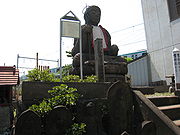
Kozukappara execution grounds
Encyclopedia

Edo
, also romanized as Yedo or Yeddo, is the former name of the Japanese capital Tokyo, and was the seat of power for the Tokugawa shogunate which ruled Japan from 1603 to 1868...
(the forerunner of present-day Tokyo
Tokyo
, ; officially , is one of the 47 prefectures of Japan. Tokyo is the capital of Japan, the center of the Greater Tokyo Area, and the largest metropolitan area of Japan. It is the seat of the Japanese government and the Imperial Palace, and the home of the Japanese Imperial Family...
, Japan
Japan
Japan is an island nation in East Asia. Located in the Pacific Ocean, it lies to the east of the Sea of Japan, China, North Korea, South Korea and Russia, stretching from the Sea of Okhotsk in the north to the East China Sea and Taiwan in the south...
) where the Tokugawa shogunate
Tokugawa shogunate
The Tokugawa shogunate, also known as the and the , was a feudal regime of Japan established by Tokugawa Ieyasu and ruled by the shoguns of the Tokugawa family. This period is known as the Edo period and gets its name from the capital city, Edo, which is now called Tokyo, after the name was...
executed criminals in the Edo period
Edo period
The , or , is a division of Japanese history which was ruled by the shoguns of the Tokugawa family, running from 1603 to 1868. The political entity of this period was the Tokugawa shogunate....
. Alternate romanized spellings are Kozukahara and Kotsukappara.
The site is located in modern Minami Senju, Arakawa, Tokyo
Arakawa, Tokyo
is a special ward located in Tokyo, Japan. The ward takes its name from the river, the Arakawa, though the Arakawa River does not run through or touch the ward. Its neighbors are the wards of Adachi, Kita, Bunkyo, Taito and Sumida. In English, the ward calls itself Arakawa City.Arakawa has...
, a three-minute walk away from Minami-Senju Station
Minami-Senju Station
is a railway station in Arakawa, Tokyo, Japan, opeated by East Japan Railway Company , Tokyo Metro, and the Metropolitan Intercity Railway Company...
. Located next to Enmeiji Temple, a large part of the grounds are now covered by railway tracks.
It is estimated that between 100,000 and 200,000 people were executed here. Those executed include Hashimoto Sanai and Yoshida Shōin
Yoshida Shoin
Yoshida Shōin was one of the most distinguished intellectuals in the closing days of the Tokugawa shogunate...
, who were executed as a result of the Ansei Purge
Ansei Purge
The Ansei Purge was a purge, in 1858 and 1859, of over 100 people from the bakufu, various han, and the Japanese Imperial court...
.
Sugita Genpaku
Sugita Genpaku
was a Japanese scholar who was known for his translation of Kaitai Shinsho .Besides Kaitai Shinsho, he also authored Rangaku Kotohajime ....
, Nakagawa Jun'an
Nakagawa Jun'an
was a Japanese doctor, botanist, and scholar of rangaku . He was a junior colleague of Sugita Genpaku, with whom he studied and worked in Obama Domain, Wakasa Province, a center for Western medicine in Edo period Japan...
, Katsuragawa Hoshū
Katsuragawa Hoshu
was a Japanese physician and scholar of rangaku . He served the Tokugawa shogunate as a physician and as a translator of Dutch. He was the older brother of author and rangaku scholar Morishima Chūryō....
and their colleagues studied anatomy by conducting dissections at Kozukappara.
Kozukappara began operation in 1651, and continued until the Meiji period
Meiji period
The , also known as the Meiji era, is a Japanese era which extended from September 1868 through July 1912. This period represents the first half of the Empire of Japan.- Meiji Restoration and the emperor :...
. Executions were stopped in an attempt to convince Western powers to end the unequal treaties with Japan.

